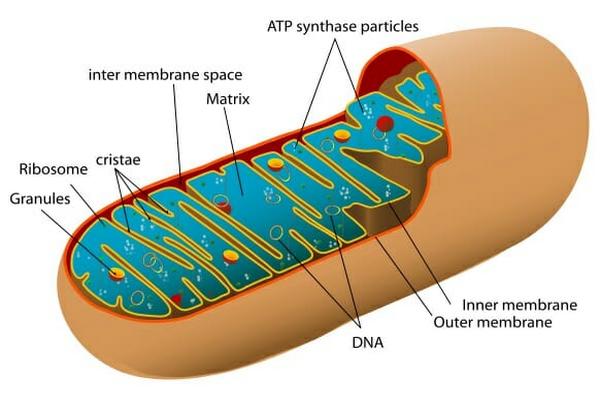Structure and Functions of Mitochondria
What is Mitochondria?

Mitochondria are rod-shaped, filamentous, and spherical membrane-bound organelles of cytoplasm.
Size of Mitochondria:
Wide→0.5-1µm
length→ 10 µm
The number and shape of the mitochondria, as well as the numbers of cristae present, can differ widely from cell type to cell type. Each cell contains a different number of mitochondria. The number of mitochondria is dependent upon how much energy the cell requires.
- Every cell has mitochondria.
- A liver cell contains more than 2000 mitochondria.
- Mature Red Blood Cells (RBC) have none at all.
- Tissues with intensive oxidative metabolism— e. g. heart muscle—have mitochondria with especially large numbers of cristae.
- Around 40% of the cytoplasmic space is taken up by mitochondria in heart muscle cells.
- In sperm cells, the mitochondria are spiraled in the midpiece and give energy for tail speed.
- Fat cells have many mitochondria because they reserve a lot of energy.
- Muscle cells also have many mitochondria, which allow them to respond fast to the need for doing work.
Structure of Mitochondria:
It includes-
- Mitochondria are made of two membranes.
- The external membrane covers the organelle and contains it like skin.it is fairly smooth.
- The internal membrane folds over many times and makes layered structures called cristae and tube-like protrusions are called tubules.
- Cristae increase the surface area of the membrane, therefore increasing the space available for chemical reactions to produce ATP.
- The inner-membrane space is located between the inner and the outer membranes that hold protein.
- The inner mitochondrial membrane is completely impermeable even to small molecules (except O2, CO2, and H2O).
- Matrixes are amorphous material between the cristae. It is rich in protein and containing DND and RNA.
- The matrix contains a highly-concentrated mixture of hundreds of enzymes, special mitochondrial ribosomes, tRNA, and several copies of the mitochondrial DNA genome.
- Mitochondria have their circular genome and ribosomes (the 70s) to synthesize their proteins.
- Enzymes for a cystic acid cycle, β-oxidation of fatty acid, and oxidative phosphorylation are found within the matrix space.
- Mitochondria reproduce by binary fission.
What are the Main Functions of Mitochondria?
All the functions of mitochondria have described below:
- The key function of the mitochondria is to produce energy (called powerhouse).
- The ordinary molecules of nutrition are sent to the mitochondria to be processed and to produce charged molecules.
- These charged molecules join with oxygen and produce ATP molecules in the cell. This process is known as Oxidative Phosphorylation.
- Mitochondria work as a digestive system that takes in nutrients breaks them down and makes energy-rich molecules for the cell.
- The liver cell’s mitochondria have enzymes that help to detoxify ammonia.
- Mitochondria assist the cells to keep the proper concentration of calcium ions within the compartments of the cell until they are needed.
- The mitochondria also help in creating certain parts of blood and hormones like testosterone and estrogen.
- The mitochondria also play a key role in the process of apoptosis or programmed cell death.
- Mitochondria secrete cytochrome C, which activates caspase, one of the chief enzymes related to destroying cells during apoptosis.
- Abnormal death of cells due to the dysfunction of mitochondria can affect the function of an organ such as muscle weakness, heart, liver, or kidney disease, Parkinson’s disease, Parkinson’s disease, autism, etc.

Maria Khatun Mona is a Founder and Editor of Nursing Exercise Blog. She is a Nursing and Midwifery Expert. Currently she is working as a Registered Nurse at Evercare Hospital, Dhaka, Bangladesh. She has great passion in writing different articles on Nursing and Midwifery. Mail her at “maria.mona023@gmail.com”
